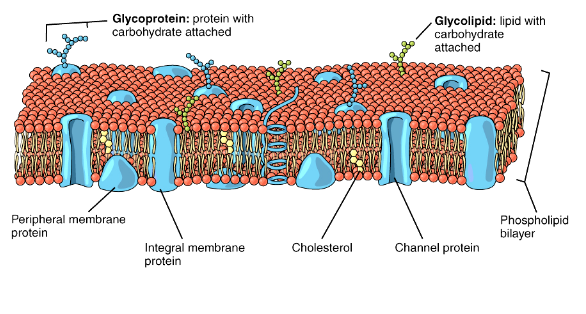
Who proposed the Fluid mosaic model of the plasma membrane and when? Describe the fluid mosaic model of the plasma membrane with the help of the diagram.
Answer
567.6k+ views
Hint: The cell has various layers which will provide them protection, fluidity and elasticity. The cell components can be mobile due to these layers, they do not let the cell sap to elucidate. They form a rigid outer wall/membrane protecting it from the exterior tensions.
Complete answer:

Plasma membrane is the cell membrane that separates the interior and exterior components of the cell from the surroundings. The cell wall is on the outer side of the plasma membrane.
The fluid mosaic model was proposed by Singer and Nicolson in 1972, to explain the structure of the plasma membrane. It was based on the thermodynamic principles of organization of membrane lipids and proteins. It also gives evidence of lateral motility in the membrane matrix.
According to the Fluid mosaic model, there is a lipid bilayer having proteins embedded in them. This bilayer provides elasticity and fluidity to the membrane. It restricts the lateral diffusion of membrane components because it has the two-dimensional liquid. There is little amount of carbohydrates in this layer.
The bilayer has phospholipids, proteins, cholesterol and carbohydrates. It is the most accepted model depicting the differentiation of the cell from the exterior.
The previous models given were the Robertson Unit membrane model and Davson-Danielli tri-layer Model. They were having some objections so this model was proposed. The fluidity of membrane was determined by x-ray diffraction and calorimetry. This showed that the integral proteins diffuse at rates which are affected by the viscosity of the bilayer.
Note: Plasma membrane has a width of about 5-10 mm. It is named so because the movement of mosaic molecules make the layer impossible to penetrate. The different molecules are scattered in the bilayer. A phospholipid is the main structural component of the bilayer.
Complete answer:

Plasma membrane is the cell membrane that separates the interior and exterior components of the cell from the surroundings. The cell wall is on the outer side of the plasma membrane.
The fluid mosaic model was proposed by Singer and Nicolson in 1972, to explain the structure of the plasma membrane. It was based on the thermodynamic principles of organization of membrane lipids and proteins. It also gives evidence of lateral motility in the membrane matrix.
According to the Fluid mosaic model, there is a lipid bilayer having proteins embedded in them. This bilayer provides elasticity and fluidity to the membrane. It restricts the lateral diffusion of membrane components because it has the two-dimensional liquid. There is little amount of carbohydrates in this layer.
The bilayer has phospholipids, proteins, cholesterol and carbohydrates. It is the most accepted model depicting the differentiation of the cell from the exterior.
The previous models given were the Robertson Unit membrane model and Davson-Danielli tri-layer Model. They were having some objections so this model was proposed. The fluidity of membrane was determined by x-ray diffraction and calorimetry. This showed that the integral proteins diffuse at rates which are affected by the viscosity of the bilayer.
Note: Plasma membrane has a width of about 5-10 mm. It is named so because the movement of mosaic molecules make the layer impossible to penetrate. The different molecules are scattered in the bilayer. A phospholipid is the main structural component of the bilayer.
Recently Updated Pages
Master Class 12 Business Studies: Engaging Questions & Answers for Success

Master Class 12 Economics: Engaging Questions & Answers for Success

Master Class 12 English: Engaging Questions & Answers for Success

Master Class 12 Maths: Engaging Questions & Answers for Success

Master Class 12 Social Science: Engaging Questions & Answers for Success

Master Class 12 Chemistry: Engaging Questions & Answers for Success

Trending doubts
December 10th of 1948 is an important day in the history class 12 sst CBSE

Prove that a parallelogram circumscribing a circle-class-12-maths-CBSE

Dihybrid cross is made between RRYY yellow round seed class 12 biology CBSE

The correct structure of ethylenediaminetetraacetic class 12 chemistry CBSE

What is the Full Form of PVC, PET, HDPE, LDPE, PP and PS ?

The first microscope was invented by A Leeuwenhoek class 12 biology CBSE




